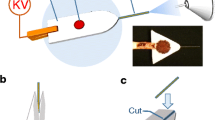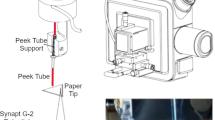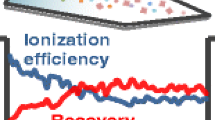Abstract
We develop a capillary-paper spray (CPS) ion source which allows for sample separation in the capillary and enables rapid and sensitive paper spray (PS) mass spectrometry (MS) analysis of biofluids. The CPS employs a glass capillary to load liquid analytes, vertically standing at the rear of the PS. To further reduce the matrix effect, a nitrocellulose filter membrane is placed between the glass tube and chromatography paper to absorb proteins and other macromolecules, which is beneficial for the detection of the small molecules. Compared with the normal PS method, the CPS method markedly improves spray stability and prolongs analysis duration, and also generates significantly better signal intensities during the analysis of drugs, thus indicating its potential for clinical use. As a proof of concept, quantitative analysis of drugs (metformin hydrochloride and berberine hydrochloride) in serum is performed.
Graphical abstract






Similar content being viewed by others
Availability of data and material
All data and materials are available.
Change history
26 March 2021
A Correction to this paper has been published: https://doi.org/10.1007/s00216-021-03299-3
References
Annesley TM. Ion suppression in mass spectrometry. Clin Chem. 2003;49(7):7.
Taylor PJ. Matrix effects: the Achilles heel of quantitative high-performance liquid chromatography–electrospray–tandem mass spectrometry. Clin Biochem. 2005;38(4):328–34.
Vega C, Spence C, Zhang C, Bills BJ, Manicke NE. Ionization suppression and recovery in direct biofluid analysis using paper spray mass spectrometry. J Am Soc Mass Spectrom. 2016;27(4):726–34.
Sterner JL, Johnston MV, Nicol GR, Ridge DP. Signal suppression in electrospray ionization Fourier transform mass spectrometry of multi-component samples. J Mass Spectrom. 2000;35(3):385–91.
Takáts Z, Wiseman JM, Gologan B, Cooks RG. Mass spectrometry sampling under ambient conditions with desorption electrospray ionization. Science. 2004;306(5695):471–3.
Cody RB, Laramée JA, H Dupont D. Versatile new ion source for the analysis of materials in open air under ambient conditions. Anal Chem. 2005;77(8):2297.
McEwen CN, McKay RG, Larsen BS. Analysis of solids, liquids, and biological tissues using solids probe introduction at atmospheric pressure on commercial LC/MS instruments. Anal Chem. 2005;77(23):7826–31.
Nemes P, Vertes A. Laser ablation electrospray ionization for atmospheric pressure molecular imaging mass spectrometry. Anal Chem. 2007;79(21):8098–106.
Harper JD, Charipar NA, Mulligan CC, Zhang X, Cooks RG, Ouyang Z. Low-temperature plasma probe for ambient desorption ionization. Anal Chem. 2008;80(23):9097–104.
Na N, Zhao M, Zhang S, Yang C, Zhang X. Development of a dielectric barrier discharge ion source for ambient mass spectrometry. J Am Soc Mass Spectrom. 2007;18(10):1859–62.
Chen H, Venter A, Cooks RG. Extractive electrospray ionization for direct analysis of undiluted urine, milk and other complex mixtures without sample preparation. Chem Commun. 2006;42(19):2042.
Wang H, Liu J, Cooks RG, Ouyang Z. Paper spray for direct analysis of complex mixtures using mass spectrometry. Angew Chem Int Ed. 2010;49(5):877–80.
Liu J, Wang H, Manicke NE, Lin J-M, Cooks RG, Ouyang Z. Development, characterization, and application of paper spray ionization. Anal Chem. 2010;82(6):2463.
Chiang S, Zhang W, Ouyang Z. Paper spray ionization mass spectrometry: recent advances and clinical applications. Expert Rev Proteomic. 2018;15(10):781–9.
Zhang M, Lin F, Xu J, Xu W. Membrane electrospray ionization for direct ultrasensitive biomarker quantitation in biofluids using mass spectrometry. Anal Chem. 2015;87(6):3123–8.
Zhang C, Manicke NE. Development of a paper spray mass spectrometry cartridge with integrated solid phase extraction for bioanalysis. Anal Chem. 2015;87(12):6212–9.
Bills BJ, Manicke NE. Development of a prototype blood fractionation cartridge for plasma analysis by paper spray mass spectrometry. Clin Mass Spectrom. 2016;2:18–24.
Ren Y, Chiang S, Zhang WP, Wang X, Lin ZQ, Ouyang Z. Paper-capillary spray for direct mass spectrometry analysis of biofluid samples. Anal Bioanal Chem. 2016;408(5):1385–90.
Deng J, Wang W, Yang Y, Wang X, Chen B, Yao ZP, et al. Slug-flow microextraction coupled with paper spray mass spectrometry for rapid analysis of complex samples. Anal Chim Acta. 2016;940:143–9.
Hundal RS, DSE I. Metformin Drugs. 2003;63(18):1879–94.
Daugan M, Wojcicki AD, d’Hayer B, Metformin BV. An anti-diabetic drug to fight cancer. Pharmacol Res. 2016;113:675–85.
Kajbaf F, De Broe ME, Lalau JD. Therapeutic concentrations of Metformin: a systematic review. Clin Pharmacokinet. 2016;55(4):439–59.
Funding
This work was supported by the National Natural Science Foundation of China (Grant Nos. 21675160, 21827807, 21625504, and 21790390/21790392), and the Chinese Academy of Sciences.
Author information
Authors and Affiliations
Corresponding authors
Ethics declarations
Conflict of interest/competing interests
There are no conflicts to declare.
Code availability
Not applicable.
Additional information
Publisher’s note
Springer Nature remains neutral with regard to jurisdictional claims in published maps and institutional affiliations.
Supplementary Information
ESM 1
(PDF 699 kb)
Rights and permissions
About this article
Cite this article
Liu, C., Li, Y., Xiong, C. et al. Development of capillary-paper spray for small-molecule analysis in complex samples. Anal Bioanal Chem 413, 1099–1106 (2021). https://doi.org/10.1007/s00216-020-03072-y
Received:
Revised:
Accepted:
Published:
Issue Date:
DOI: https://doi.org/10.1007/s00216-020-03072-y




